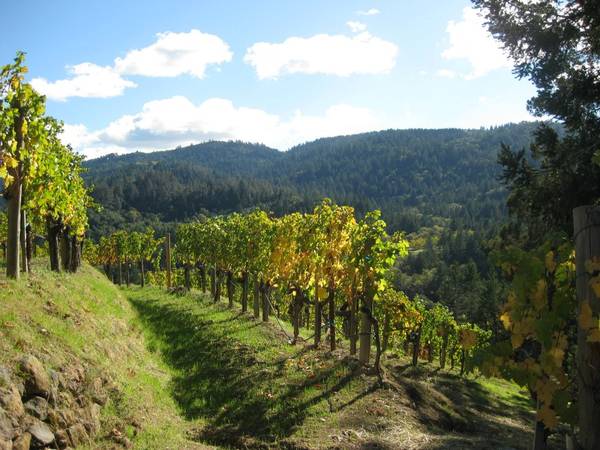Nestled in the Mayacamas range on the western side of Napa, west of Calistoga on the northern edge of the Napa-Sonoma county line, is the historic, high altitude AVA of Diamond Mountain District.
The whole of the AVA encompasses a land area of around 5000 acres and sits at around 400 ft. above sea level with most vineyards falling somewhere between 650 ft to 800 ft above sea level and is situated closer to Sonoma, making it theoretically a cooler region compared to other Napa AVAs, however it is actually among Napa’s warmest. That doesn’t mean lesser wines nonetheless. The higher altitude actually places the grapes in an area closer to and with more direct sunlight as the regions height protects it from the San Pablo Bay fog that rolls in from the south into the Napa Valley in the evenings, and porous volcanic soils in the region (it is an extinct volcano…hopefully extinct…) make for great drainage and allows the vines to optimize the cooler night temps by cooling the roots quicker than the foot hills and valley floor plantings in the whole of Napa Valley – aiding in great acidity and balance within the grapes themselves.
While it seems like sound logic that the area is an ancient volcano, has volcanic soils, and is called Diamond Mountain, there was no actual diamond rush in the region nor is it named for its famed diamonds. The name comes from the bits of volcanic glass that are intermingled in the soils of the region.
While we are talking about the name, it’s common place to just say “Diamond Mountain” in reference to wines from the area, however it’s interesting to point out that the proper name is Diamond Mountain District. This is due to the fact that the actual peak of Diamond Mountain resides in Sonoma, just across the county line, and this caused some fighting regarding the AVA lines when establishing the AVA after proposal in 1999. The specific naming was settled on as county lines were not going to be redrawn to service a few upset winemakers.
You may have heard of Jacob Schram, or seen his name styled J. Schram in his famous signature. If you don’t, maybe you recognize the name Schramsberg? Jacob purchased an area of land in 1868 on the Napa side of the border and was the first to plant vineyards in the area, eventually growing his holdings to encompass an area of around 100 acres, complete with an underground cellar. In namesake, Schramsberg Vineyards continues on very well to this day. Every state function by every President since Nixon has been serving these wines, not to mention it was the first American wine to be served in such capacity. In 2000, J. Davies took over the Schramsberg vineyards and began producing Cabernet in his own namesake, to great acclaim.
While there are other plantings in the AVA, today it is primarily dominated by Cabernet Sauvignon, followed by Cabernet Franc and Petit Verdot.
There are a number of wines we’d recommend from this region, but if you haven’t had a bottle of Schramsberg before or are unfamiliar with the name, do yourself the justice of grabbing some and seeing what all the fuss is about, you won’t be disappointed with anything they make. Hell, you won’t be disappointed with any wine from Diamond Mountain District as a whole, especially the Cabs. Enjoy!

